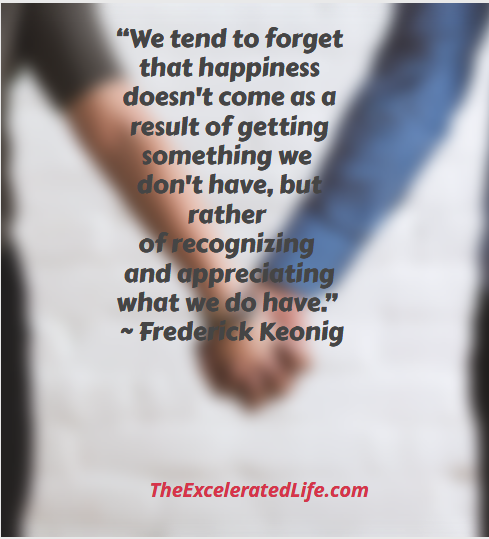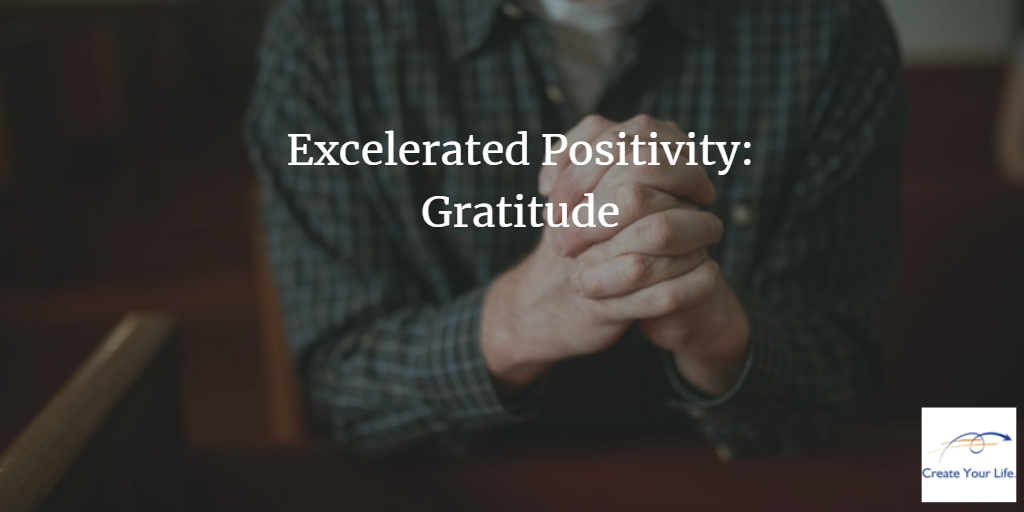Research shows a correlation between feeling grateful and overall life satisfaction. Expressing gratitude is one of the surest ways to increase your positivity and well-being. In addition, you’ll improve the well-being of others when you express your thanks to them.
The Excelerated Life, LLC
Title Photo by RODNAE Productions from Pexels

[What you may learn: Research in positive psychology has shown that different people have different levels of positivity but there is a certain percentage that we can influence. After reading, see if you remember that number.]
“You don’t have to wait for a thing to happen to be grateful for it. You can start the cycle at any time.” ~ Holiday Mathis
Research in the field of positive psychology has determined that we have the power to influence a large chunk of our happiness — about 40%, which represents those things under our control. The research indicates that there are certain actions we can take to increase feelings of happiness and well-being. One of the most accessible and universal happiness tools is gratitude. [Seligman]
There is increasing evidence that “grateful people are more attentive, determined, energetic, enthusiastic, helpful. interested, joyful, and optimistic than those who aren’t. On top of that, recent research suggests that gratitude is strongly related to what psychologists call your ‘sense of coherence’, your belief that life is manageable, meaningful, and understandable.” [Grenville-Cleve]
The Benefits Of Gratitude
Expressing gratitude
- promotes savoring of positive life experiences.
- bolsters self-worth and self-esteem and breaks the habit of focusing on failures and disappointments.
- helps you cope with stress and trauma.
- during personal adversity can help you adjust and move on, or start anew. While this is challenging and difficult, it may be the most important thing you can do when dealing with adversity.
- encourages moral behavior.
- helps build social bonds, strengthens existing relationships and nurtures new ones.
- inhibits undesirable comparisons with others.
- is incompatible with negative emotions and may diminish feelings of anger, bitterness, and greed.
- helps thwart hedonic adaptation – the tendency to rapidly adjust to new circumstances or events.
You can improve your level of positivity and well-being by practicing Gratitude. Here’s how.
Gratitude Journal
Choose a time when you have several minutes to reflect on your life. Ponder 3 – 5 things for which you are currently grateful, from the every day to the sublime. These can include people who have helped you, things you are good at, goals you have accomplished, advantages or opportunities you have enjoyed. On average, doing this exercise once a week is most effective. But that is an average. Some people benefit more from doing it 3 times a week or every other week or some other time period. Experiment to find what works best for you.
Express Gratitude Directly To Another
Select someone to whom you owe a particular debt of gratitude. Express your appreciation to that person in a letter. Describe in detail what he or she did for you and how it affected your life. Mention how frequently you remember his or her efforts. Then select a day to visit with the person and read them the letter. Give them a copy.
Or you may choose to write to a person you don’t know personally but who has influenced your life or made your life easier. Then mail the letter to the person.
Sometimes, you may choose to write the letter but not send it. Studies have shown that simply writing a gratitude letter, but not sending it, was enough to boost happiness.
Instead of a letter, you can express your gratitude to a person face-to-face or in a phone call.
Paths To Gratitude
Here are other ways to count your blessings. Again, experiment to see which works best for you.
- Choose a fixed time to contemplate on something or someone for which you are grateful. Think of why you are grateful and how it (or she or he) has enriched your life.
- Choose one thing each day that you usually take for granted or that goes unappreciated and express gratitude for it.
- Acknowledge one ungrateful thought per day and substitute a grateful one in its place.
- Choose a gratitude partner and share your blessings list with each other.
- Introduce a visitor to the things, people, and places that you love, to see these through another’s eyes.
Keep The Strategy Fresh
Keep your gratitude strategy fresh by varying it and not over practicing it. Research suggests that variety is important.
You may choose to write in a journal some weeks, send a gratitude letter on another week, talk to a friend some weeks, and express gratitude through some other creative way on other weeks. Or vary your expression of gratitude to focus on different areas of your life and relationships each week.
There are multiple ways to express gratitude. Choose what works best for you, then vary the routine to help keep it a meaningful practice, so it continues to boost your happiness level.
What Gratitude Is Not
True gratitude comes from the heart. It feels good to express your thanks when you feel the urge to give something in return, either to the person who helped you or to “pay it forward” in some way.
But, as Barbara Fredrickson warns us: “Gratitude, though, has an evil twin: indebtedness. If you feel you have to pay someone back, then you’re not feeling grateful, you’re feeling indebted, which often feels distinctly unpleasant. Indebtedness pays back begrudgingly, as part of the economy of favors. In contrast, gratitude gives back freely and creatively. It’s a truly pleasant feeling intermixed with joy and heartfelt appreciation.” [Fredrickson]
When you mumble an obligatory “Thanks” to someone, you’re being polite, not grateful. “Gratitude is not mindless manners or tit-for-tat reciprocity,” writes Fredrickson. “True gratitude is heartfelt and unscripted.” [Fredrickson]
Where Do I Go From Here?
[Before you read further, take a moment to quiz yourself on what you’ve read. There is a certain percentage of our positivity and well-being that we can influence through practice. What is that percentage? Got it? Good. Now continue to see if you got it right.]
A correlation has been shown between feeling grateful and overall life satisfaction. “The higher your gratitude, the happier you’ll feel, and vice versa.” [Grenville-Cleve] In addition, you’ll improve the well-being of others when you express your thanks to them. “Everyone likes to feel appreciated.” [Grenville-Cleve]
Even if you don’t think you have anything major for which you could express gratitude, look around you. You’ll find many, many small things to be thankful for.
So if you are interested in improved health and well-being, improved physical abilities, improved mental functioning, and better coping skills, start doing things to influence the 40% of happiness that we can effect. Start small by choosing one or two exercises that have been shown to increase happiness levels. You can begin reaping the benefits of this science right away. That’s how you embrace your Excelerated Life™!
Excelerated Positivity™ — building the skills in positivity that help you flourish — is one step in creating your Excelerated Life™, a life of flourishing and well-being, and a life of meaning, purpose, and service.
Read more about the Excelerated Life™.
Resources:
Fredrickson, Ph.D., Barbara, L. Positivity. New York: Crown Publishing Group, 2009.
Grenville-Cleave, Bridget. Positive Psychology: A Practical Guide. New York: MJF Books. 2012.
Lyubomirsky, Sonja. The How Of Happiness. New York: Penquin Books, 2007.
Seligman, Ph.D., Martin E. P. Authentic Happiness. New York: Free Press, 2002.



One Reply to “Excelerated Positivity: Gratitude”